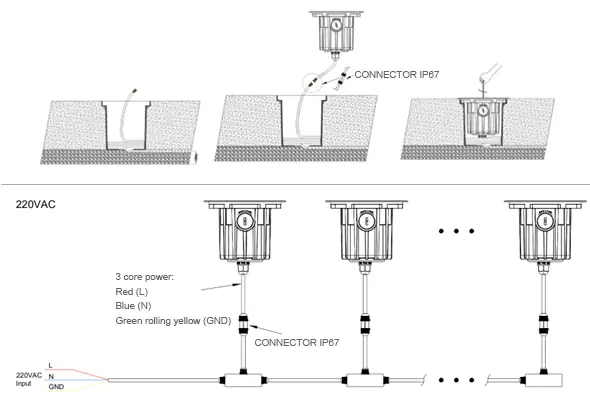LED underground or ground lights are very popular because they can illuminate a space without disrupting the landscape. They are most commonly found in paths and gardens, but are also useful for lighting elsewhere.
;
What is underground lighting?
;
Underground light is a type of lighting that is installed underground to illuminate sidewalks, parking lots, and other walkways. It can also be used to illuminate gardens and landscaping. Installing underground lighting is a perfect solution for illuminating hard to reach spaces.
;
What are the benefits of underground light
;
- You can have a lower electric bill when you opt for underground light because these are much more efficient.
- Not only do LEDs last a lot longer than other types of lights, they require less upkeep in the process. The only thing that this might impact negatively is the aesthetic aspect; sin embargo, the light not requiring upkeep can end up saving you a lot of time and money in the long run.
- When you’;re browsing underground light, you’;ll notice you have a choice of effects, brightness levels, and angles to direct them. This means you have complete control and an extraordinary range of customization.
- LED well lights are incredibly versatile thanks to their wide range of brightness levels and other effects. No matter what situation you’;re in, you’;ll likely find something that works.You and your guests can stay safe by installing underground light. To do so, they illuminate any obstacles along the path and reduce the risk of tripping and falling.
- The bulb of underground light fixtures is sunk into the ground rather than being elevated above ground level, so it won’;t overshadow your surroundings like a larger pole light or bright bulb might. These light fixtures are ideal for getting light without obscuring what’;s in the landscape.
- underground light can also reduce trip risks because they do not protrude from the ground. Sin embargo, the surface level may still vary slightly with the light, but it will be much less than with other forms of lights.As the lights don’;t go above the ground, they are less likely to be damaged by foot traffic, stray balls, or other objects.
;
Where is the underground light used?
;

Since underground lights are mounted at the top of the ground, deberá tener en cuenta dónde planea usar la luz. Underground lights are most commonly used for sidewalks and other areas that require light but don’;No tengo mucho espacio para un accesorio sobre el suelo..
También puedes usarlos como iluminación de acento o como luz de seguridad en las entradas.. A la hora de decidir qué tipo de luz subterránea es mejor para su hogar, debe considerar dónde está disponible la energía y si hay una fuente de luz existente cerca. Que no, instalar una lámpara subterránea puede ser difícil. En general, no funcionan bien en espacios reducidos o rincones oscuros porque tienen un área amplia de iluminación en lugar de focos como sus contrapartes sobre el suelo.
;
Cómo elegir una luz subterránea
Piensa en lo que quieres enfocar en la imagen..
Es importante decidir cuáles son sus objetivos antes de instalar la luz subterránea LED, ya que su elección estará influenciada por estos objetivos. Por ejemplo, si quieres iluminar una pequeña planta, una luz de bajo voltaje probablemente será suficiente. Cuanto más brillante es la luz, mejor si quieres iluminar un camino o algo alejado del suelo.
Considere qué tipo de iluminación desea.
Tendrá que elegir entre los distintos tipos de luz subterránea descritos anteriormente. Tu elección dependerá en gran medida de la cantidad de luz que quieras que entre y en qué dirección quieras que apunte..
Considere el brillo también.
Preste atención a la potencia de las luces al elegirlas. Su brillo estará determinado principalmente por su potencia. Cuantos más vatios, cuanto más brillante es la luz. Cuantos menos vatios, el atenuador de la luz.
Make sure it’;clasificado para uso en exteriores.
Asegúrese de que las luces de pozo que compre estén clasificadas para uso en exteriores. Este no es el caso con todas las luces., así que lea la descripción del producto primero. Dado que las luces exteriores estarán expuestas a la lluvia, viento, suciedad, y otros elementos, deberían tener una calificación de uso al aire libre.
;
Instalación de luces subterráneas

1.Si es posible, intente instalar la torre de escalada en terreno suelto o blando.
El proceso de instalación de un LED subterráneo será más sencillo cuando se realice en un suelo más blando; será mucho más fácil moverse y nivelar la tierra.
2.Cavar un hoyo o una zanja.
Pon tu lámpara en el suelo, sobre 3 a 4 pulgadas de ancho y 12 pulgadas más profundo que el accesorio mismo.
Lo único que queda por hacer es llenar el agujero con un poco de grava ligera..
3.Asegúrese de que el cableado esté en orden.
Después de instalar la lámpara, you’;querré conectarlo a la alcantarilla. Siempre asegúrese de dejar suficiente holgura en el cable para poder enterrarlo si es necesario.. Tomar estas medidas preventivas antes de terminar la instalación significa que, si luego elige cambiar la ubicación de la luz, el cableado no tendrá que hacerse todo de nuevo.
4.Rellene la suciedad restante y nivele.
Finalmente, rellena el resto del hoyo con tierra, mantener el accesorio nivelado y despejado.
5.Differences when using concrete &; mortero
Para luces subterráneas de hormigón, necesitará colocar una pieza hueca en el agujero que cava, luego vierta en concreto. También es una buena idea pasar el conducto a través de esta pieza para asegurarse de que el cable sea adecuado para la luz.. Cuando el hormigón está seco., desliza la luz en la pieza hueca.
;
Conclusión
Luces LED subterráneas don’;t interrupt the natural surroundings and aren’;Es probable que cause lesiones como tropezar o correr.. Es posible que los vea a lo largo de los caminos e iluminando todo un paisaje.. Hay muchas opciones de iluminación exterior disponibles, como linternas de Lacelesty Lighting. Póngase en contacto con nosotros hoy para obtener más información..







